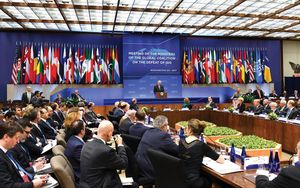The Reserve Bank of India (RBI) is expected to cut interest rates for the first time in nearly five years on Friday, as concerns about stubborn inflation wane, according to economists and investors surveyed by ET. The RBI's changing priorities aim to help spur the visibly slowing economy.
Nine out of the twelve financial institutions polled believe the restructured Monetary Policy Committee (MPC), meeting for the first time under new Governor Sanjay Malhotra, will vote to reduce the repo rate by 25 basis points to 6.25%. This potential reduction would mark the first such move since May 2020, when rates were slashed to cushion the impacts of Covid-19.
"Revenue expenditure as a proportion of GDP was reduced from 11.4% to 11%—this is fiscally prudent," commented Gaura Sengupta, chief economist at IDFC First Bank. She expressed optimism, stating, "From the MPC perspective, the deficit numbers won't have a bearing on rate cuts. This would be a good time to cut rates as inflation has eased and is expected to ease." Abhishek Upadhyay, senior economist at ICICI Securities, echoed this sentiment, emphasizing the importance of cutting rates to facilitate growth management.
Nevertheless, three participants from the poll expressed skepticism about the likelihood of immediate rate cuts. While many central banks around the world, like the U.S. Federal Reserve, have already embarked on easing cycles, the RBI has been cautious owing to persistent inflation challenges, primarily linked to food prices. Until recently, the MPC argued against premature rate cuts, fearing such actions could inadvertently allow inflation to spiral.
Recent economic data paints a mixed picture: inflation dropped to 5.2% from 5.5% in November, yet GDP growth for the quarter ending September 2024 fell to 5.4%. This slowdown has raised concerns due to subdued consumption and declining corporate profits. Meanwhile, overnight index swap (OIS) rates, which currently are at 6.33%, suggest traders anticipate loosened monetary policies, corroborated by RBI's recent liquidity measures.
The RBI's introduction of various bond purchases and repo auctions signals forthcoming easing, yet external pressures complicate India's monetary policy responses. The Indian rupee has depreciated over 3% since November, sitting at 86.6 per dollar, leading to significant liquidity concerns. Some experts believe this volatility may push the RBI to delay any rate cuts until April when they will have clearer visibility on liquidity and currency markets.
Rajeev Radhakrishnan, chief investment officer for fixed income at SBI Mutual Fund, argued, "A rate cut now will not have the desired impact as rates would not be effectively transmitted. We would need to establish neutral to surplus liquidity conditions for effective response from rates." Adding to this uncertainty, several investors suspect the RBI might reduce the Cash Reserve Ratio (CRR) again but remain hesitant due to recent liquidity-boosting strategies.
Looking back at broader fiscal strategies, the recent Union Budget has presented the RBI with compounded challenges and opportunities. It emphasizes fiscal prudence without straying from growth initiatives. The infusion of Rs 1.5 trillion through various financial instruments is meant to address significant liquidity deficits, with the expectation of easing monitory policies post-budget.
Meanwhile, global economic signals cannot be ignored; the Fed’s recent policy meeting and forthcoming decisions from the Bank of England aligned with easing sentiments, potentially increasing pressure on the RBI to follow suit. The Bank of England has announced plans for future rate adjustments, reflecting growing global trends toward monetary relaxation.
"The emphasis on managing both local and international economic environments can lead the RBI to take varied approaches," stated Tuhin Kanta Pandey, the finance secretary. He expressed the need for the Indian economy to align with the international narrative of easing rates as inflation decreases. He added, “Inflation is waning, both domestically and externally."
Despite prevailing challenges, such as geopolitical tensions affecting commodity prices, there remains optimism among economists and market participants. HSBC Global Research anticipates two rate cuts of 25 basis points each within the first half of 2025, noting, "Falling inflation rates, limited fiscal support, and easing growth likely necessitate monetary intervention."
While the pressure mounts for the RBI to cut rates, insights highlight its carefully balanced priorities between managing inflation and revitalizing growth amid fluctuative currency patterns. This delicate dance of fiscal responsibility and economic stability will undoubtedly shape the RBI's strategy and influence future market behaviors.
Looking forward, economic observers and stakeholders alike are holding their breath as the RBI stands on the brink of potentially transformative decisions for India's economic future.



